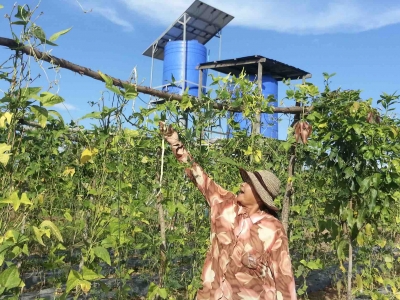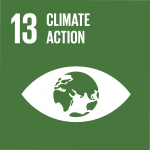Cambodia strengthens climate action coordination with ministries, private sector and community-based organizations

November 2021 – Climate change is expensive. According to UNEP’s Adaptation Gap Report 2020, annual climate change adaptation costs in developing countries are estimated at USD 70 billion. This figure is expected to reach USD 140-300 billion in 2030 and USD 280-500 billion in 2050. In Cambodia – which is ranked the 12th most vulnerable country in the world to climate change by the Global Climate Risk Index 2020 – increases in the frequency of floods, droughts, and windstorms in recent years cost 10 percent of the country’s Gross Domestic Product (GDP) in 2015 from loss and damages. One-third of Cambodia’s GDP comes from the agriculture sector, that employs 57 percent of the country’s labor force. The country is highly vulnerable to flooding events due to large seasonal variations in water levels. These disruptions to logistical corridors caused by floods have a profound impact on agricultural supply chains, both domestically and for international trade.
Cambodia has long been formulating plans to adapt to climate change. As of July 2021, Cambodia submitted its ‘Cambodia Climate Change Strategic Plan’ (CCCSP) as its National Adaptation Plan (NAP) to the UNFCCC. A revised nationally determined contribution (NDC) was submitted to the UNFCCC in December of 2020. To accelerate the country’s adaptation and mitigation goals, Cambodia partnered with the Scaling up Climate Ambition on Land Use and Agriculture through nationally determined contributions (NDCs) and National Adaptation Plans (SCALA) programme, funded by Germany’s International Climate Initiative (IKI). With a NAP formulated and an NDC submitted, the SCALA programme sat down with Dr. Prum Somany, Director at the Department of International Cooperation (DIC) and Assistant to Minister of Agriculture, Forestry and Fisheries to learn about how Cambodia plans to accelerate its adaptation and mitigation goals in the agriculture and land use sector.
***
SCALA: What are some of the key priorities in agriculture and land use that have been outlined in your country’s NDC?
Dr. Prum Somany: Cambodia submitted its updated NDC to the UNFCCC in December 2020, which outlines adaptation and mitigation goals in the agriculture and land use sectors. There are 17 prioritized adaptation actions under agriculture, focusing on agribusiness, the development of rice and other cash crops, horticulture, livestock aquaculture production. The NDC adaptation component also outlines the need for agriculture support services, capacity building, enhanced institutional arrangements, the development of new technologies and increased research. Cambodia has prioritized mitigation actions under the forestry and other land use (FOLU) sectors with an aim of reducing 50 percent of emissions by 2030 via the REDD+ programme. This target is based on the REDD+ National Strategy, which was also included in the NDC as part of the recommendations from the REDD+ Technical Secretariat and the Department of Climate Change. The Ministry of Agriculture, Forestry and Fisheries (MAFF) and other relevant ministries will also undertake a bio-digester programme as part of the mitigation actions outlined in the updated NDC.
SCALA: What are some of the main barriers experienced in achieving these adaptation and mitigation goals?
Dr. Prum Somany: A key barrier for climate actions in Cambodia is limited resources: human, technical and financial resources, which could be enhanced with support from development partners and private sector financing. There is also a need to enhance capacity and technical skills in data and information collection and management, particularly for Measuring, Reporting and Verification (MRV). Other barriers include limited staff capacity at the sub-national levels in implementing adaptation and mitigation actions, as well as coordination with line ministries and other stakeholders (civil society, community-based organizations, NGOs, and the private sector) to ensure that efforts and resources are concerted, and synergies are leveraged.
SCALA: Cambodia is part of the 5-year SCALA Programme, what are the entry points for SCALA to help overcome these barriers and achieve these priorities?
Dr. Prum Somany: The SCALA programme in Cambodia is being designed to help address several of these barriers through, for example, capacity building and strengthening the evidence base for the implementation of adaptation and mitigation activities. In addition, with support from the SCALA programme, climate change considerations will be integrated into sectoral planning, budgeting and coordination, and linkages with key stakeholders such as the private sector and community-based organizations will be developed.
SCALA: What steps can be taken to reduce greenhouse gas emissions from agriculture and land use?
Dr. Prum Somany: In Cambodia, livestock significantly contributes to greenhouse gas emissions. Therefore, reducing methane emissions through improved processing of manure is an important step. At the same time, improving carbon storage in soil and vegetation through the application of climate friendly land use practices and climate-smart agriculture aligns with the National Green Growth Policy of Cambodia. Promoting renewable energy in the agricultural sector, for example, bio-slurry energy, solar energy and energy from other renewable sources will also help reduce emissions.
SCALA: Based on the key priorities identified for the agriculture and land-use sector, where do you see the private sector contributing?
Dr. Prum Somany: The private sector can play a strong role in strengthening market linkages, improving farmers’ access to quality agricultural inputs and promoting sustainable livelihoods and incomes, particularly for vulnerable communities. The MAFF has established a Public-Private Partnership (PPP) framework that provides a platform to support the private sector engagement in agribusiness value chains, capacity building for producers and to strengthen linkages between producers and buyers.
***
Cambodia’s aims to increase adaptive capacity for sectors and communities vulnerable to the impacts of climate change in the medium-to-long term of its sustainable development. As a Least Developed Country, Cambodia’s NAP overarching aim is to develop towards a green low-carbon, climate-resilient, equitable, sustainable and knowledge-based society. Over the next five years, Cambodia will be supported by the SCALA programme to strengthen coordination on climate action between ministries, the private sector and community-based organizations to support transformative change in the agriculture and land use sectors in alignment with adaptation and mitigation priorities outlined in the NDC and NAP.
